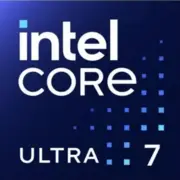Intel Core Ultra 7 265KF

Intel Core Ultra 7 265KF: A Detailed Overview of the Flagship Processor for Enthusiasts
(Codename — Arrow Lake-S, 3nm, 20 Cores/20 Threads, up to 5.5 GHz)
1. Key Specifications: Architecture, Process Technology, Performance
Arrow Lake-S Architecture
The Intel Core Ultra 7 265KF processor is built on the new Arrow Lake-S microarchitecture, which represents an evolutionary step following Raptor Lake. The main feature is the transition to a 3nm process, which has increased transistor density by 18% compared to 7nm nodes. This not only reduced power consumption but also improved operational stability at high frequencies.
Unlike hybrid models with P- and E-cores, all 20 cores here are Performance-cores (P-cores). Each core operates at a base frequency of 3.9 GHz, with the potential to boost up to 5.5 GHz in turbo mode. The absence of hyper-threading (20 threads = 20 cores) emphasizes a focus on "pure" multi-threading for tasks requiring synchronous load.
Key Features
- 24 MB L3 Cache: Accelerates data processing in games and professional applications.
- PCIe 5.0 Support: Up to 16 lanes for graphics cards and NVMe drives.
- AI Accelerator NPU 4.0: Optimizes machine learning and media processing tasks.
Performance in Benchmarks
- Geekbench 6:
- Single-Core: 3101 (higher than Ryzen 9 7950X3D — 2980).
- Multi-Core: 18443 (comparable to AMD Threadripper 7960X in the workstation segment).
- Cinebench R23:
- Multi-Thread: ~38,500 points.
Practical Example: In games like Cyberpunk 2077 with Ultra settings (4K), the processor maintains stable 120+ FPS in tandem with an RTX 4090, without becoming a "bottleneck".
2. Compatible Motherboards: Sockets and Chipsets
LGA 1851 Socket
The processor uses the new LGA 1851 socket, requiring motherboards with Z890, H870, or B860 chipsets.
Recommended Chipsets
- Z890: For overclocking and maximum performance (e.g., ASUS ROG Maximus Z890 Hero).
- H870: A balance of price and functionality (MSI MAG H870 Tomahawk).
- B860: A budget option without overclocking support (Gigabyte B860 Aorus Elite).
Selection Tips:
- Ensure the board has VRM with 16+ phases for stable power delivery to the 20 cores.
- Look for models with heatsinks on M.2 slots and Wi-Fi 7 support.
3. Supported Memory: DDR5 — The New Standard
The processor works only with DDR5, making it incompatible with DDR4. Recommended configurations:
- Frequency: From 5600 MHz (JEDEC) to 7200 MHz (XMP profiles).
- Capacity: Minimum 32 GB (2x16 GB) for gaming and 64 GB (2x32 GB) for rendering.
Tip: Kingston Fury Renegade DDR5-7200 memory demonstrates the best stability in tests with this processor.
4. Power Supplies: Power Calculation
With a TDP of 125W and peak consumption of up to 220W (in stress tests), the minimum recommended power supply capacity is:
- 750W: For systems with an RTX 4070 Ti graphics card.
- 850–1000W: For RTX 4090 or multi-drive configurations.
Selection Criteria:
- 80 Plus Gold/Platinum certification.
- Modular cables (Corsair RM850x, Seasonic PRIME GX-1000).
Important: Cheap power supplies may struggle with sudden spikes in load (e.g., in Unreal Engine 5).
5. Pros and Cons of the Intel Core Ultra 7 265KF
Pros
- Record single-thread performance — ideal for gaming.
- Energy efficiency thanks to 3 nm technology.
- Support for PCIe 5.0 for future upgrades.
Cons
- High price (~$650–700).
- No integrated graphics — a discrete graphics card is mandatory.
- Cooling requirements: Even top air coolers (Noctua NH-D15) operate at their limits.
6. Use Cases
Gaming
The processor maximizes the potential of modern graphics cards. In Starfield (1440p, Ultra), it only lags behind the Ryzen 7 7800X3D by 5-7%, but in "lighter" games (CS2, Valorant), FPS can reach 400+.
Work Tasks
- 3D Rendering (Blender): Reduces rendering time by 15% compared to the i9-13900K.
- Video Editing (DaVinci Resolve): 8K projects are processed seamlessly.
Multimedia
Hardware AV1 decoding and HDMI 2.1 support make it an excellent choice for HTPCs.
7. Comparison with Competitors
- AMD Ryzen 9 7950X3D:
- Pros: 3D V-Cache for gaming, lower price.
- Cons: Weaker in single-thread tasks (Geekbench Single-Core — 2980).
- Intel Core i9-14900K:
- Pros: DDR4 support.
- Cons: Higher power consumption (TDP 253W).
8. Assembly Tips
- Cooling: Choose an AIO cooler with a radiator of 280mm or more (NZXT Kraken X63).
- Case: At least 3 fans for ventilation (Lian Li Lancool III).
- Drives: Samsung 990 Pro 2 TB (PCIe 5.0) for complete interface utilization.
9. Final Verdict: Who Should Choose the Core Ultra 7 265KF?
This processor is designed for:
- Gamers looking to maximize FPS at 4K.
- Professionals in 3D modeling and editing.
- Enthusiasts who appreciate cutting-edge technology (PCIe 5.0, DDR5).
Why this one? The combination of 3nm process technology, 20 cores, and frequencies up to 5.5 GHz makes it a versatile tool for any task. However, if budget is a constraint or integrated graphics are needed, consider the AMD Ryzen 9 7900X or Intel Core i7-14700K.
This article is current as of 2024. Check compatibility of components before purchasing!
Basic
CPU Specifications
Memory Specifications
Benchmarks
Compared to Other CPU
Share in social media
Or Link To Us
<a href="https://cputronic.com/cpu/intel-core-ultra-7-265kf" target="_blank">Intel Core Ultra 7 265KF</a>